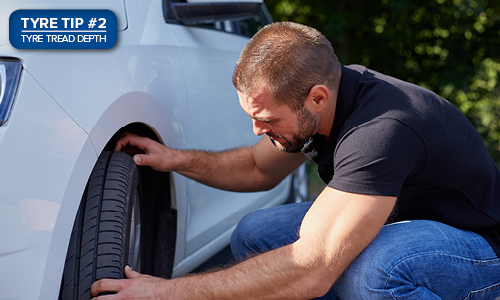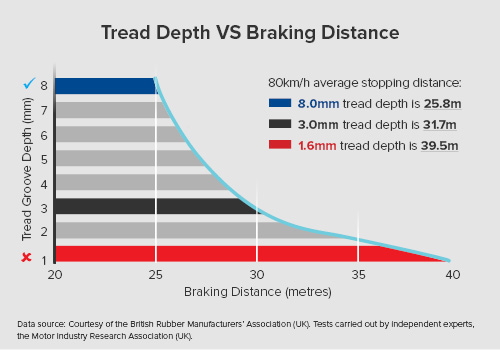Before you set off on your trip, check these tyre check tips:
Tip #1 Tyre Pressures
One of the simplest and most important things you can do to keep your tyres in good shape is to make sure that they are properly inflated. Failure to maintain correct tyre pressures may result in fast and uneven treadwear, improper vehicle handling, and excessive heat build-up which could result in tyre failure.

Over-inflation
If your tyres are over-inflated by as little as 6 psi, as an example, they could be damaged more easily when driving over potholes or debris on the road. Over inflation also causes tyres to wear in the centre of the tyre’s tread which will reduce the tread life. Over-inflated tyres will also give you a much harsher ride.
Under-inflation
If your vehicle’s tyres are under-inflated, it could lead to tyre damage. Additionally, the tyre’s tread life could be reduced significantly with tyres wearing more on the outside shoulders. Lower inflation pressure allows the tyre to flex more as it rolls causing internal heat.
What to do
You should check your tyres’ pressures at least once a month, before each trip, and each morning you drive during a trip. Ideally, tyre pressure should be measured when tyres are cold – before doing any driving on the tyres. Otherwise, your tyres may have heated up, increasing the air pressure inside them by several pounds per square inch (PSI). This is normal and as a rule never reduce the air pressure from a hot tyre, since this could result in under-inflation. Only reduce air pressure from a hot tyre when you need to lower pressures to drive on a particular terrain, but remember to re-inflate your tyres when you reach your destination, or return to terrain that requires higher pressures.
There is so much more about tyre pressures that you need to be aware of, especially if you are planning a long trip or would encounter different types of terrains. Request a copy of our famous Driver’s Guide.
Tip # 2 Tyre Tread

There are two main reasons why tread depth is important. More tread left means more mileage and the further your tyres will take you, but also it gives you shorter braking distances that are essential in sudden change of conditions or in wet conditions.
Tests carried out by independent experts at the Motor Industry Research Association in the United Kingdom demonstrate that reduced tread depths dramatically increase a vehicle’s wet braking distance. Although, 1.6mm of tread depth is the legal limit in Australia, tread depths below 3mm take considerably longer distances to brake, putting your safety at risk.

Tip # 3 Wheel Alignment and Balance

The regular care and maintenance of wheel alignment and balancing are crucial to the performance and wear of your tyres.
If you can feel that your vehicle is pulling to one side or the steering wheel isn’t straight, it means that your tyres need a wheel alignment and balance. You can also diagnose this by observing uneven wear of your tyres in the inside or outside. That’s the perfect time to go to your Cooper Authorised Retailer to get the tyres checked.
Failing to align and balance your tyres will give you an uncomfortable and unstable drive. You don’t really want that for a long drive or even putting your safety at risk when you need your tyres to stay stable and true on the road.
Tip # 4 Reliable Spare Tyre

The spare tyre is only spare when it’s not on your car. Before you head off, inspect your spare tyre to make sure it is free from cuts, nails and any evident damage. Also, make sure it has a safe tread level left and it’s properly inflated to the conditions you are planning to drive on.
Tip # 5 Avoid overloading

The excitement of a trip in the horizon can easily lead to overloading your vehicle. Driving on an overloaded tyre is hazardous. When your car is carrying too much load, the weight can create excessive heat inside your tyres – with the potential to cause sudden tyre failure. Never exceed the maximum load rating of your tyres, which you can find on the sidewall of the tyre. When you replace a tyre, make sure the new one has a load-carrying capacity equal to or greater than what is specified on your vehicle’s placard.
To avoid this, check what your load-carrying capacity is and plan accordingly. Learn what the Load Index and Speed Ratings mean.

